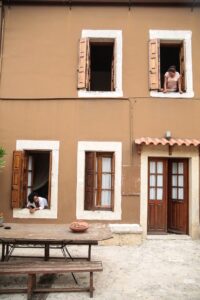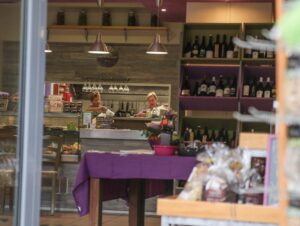[Above: Archanes from atop Mount Youchtas. All images by Olivia Locascio ]
“How about some olive oil bread and fresh squeezed lemonade?” I looked up from the wind-ruffled pages of the book I was reading. Sunlight gleamed from the beads of condensation on the icy carafe that Athena, the owner of the Troullos apartments where we were staying, had carried over on a tray, accompanied by a loaf of fresh bread.

I had been sitting beneath a bit of shade in Athena’s stone courtyard in the village of Archanes in northern Crete, reading about traditional Cretan cooking – learning about the centrality of olive oil, the healing power of wild greens, and the importance of taking time to share a meal with family and friends. This was the second afternoon in a row that Athena, who had left Athens to come to this small village with her husband, had come out to offer us refreshments. Swishing the cool, minty lemonade in my mouth, I pondered the deep generosity of this woman. There was something special about the way she wanted to share her food with us.
I stood, stretched and ambled around the courtyard where a few of the other students enrolled in my study abroad program were also relaxing. Gazing out towards the shadowed base of Mount Ida, Zeus’s birthplace, I searched for the olive trees and grape vines that are so important to this region. I marveled at this place, hardly believing that I was here – and that I would be here, on this magnificent island, for another two weeks.

Archanes, once the summer residence of Minoan kings, is now lined with narrow, sloping streets. Colorful homes are snuggled in close together and no space is left unused. Fresh cucumbers, tomatoes, and zucchini flowers fill the wooden bins of tiny markets. A small cheese shop boasts glass-faced refrigerators, crowded with rounds of myzithra and other local cheeses. Every morning and late afternoon, conversation and laughter can be heard from the open doors and windows, as passers-by stop to say hello and catch up on the day’s news.
One of my favorite shops was Bakaliko, a restaurant along the edge of the town square, where the 20 other students from the University of Wisconsin who were taking part in Nikki Rose’s program, “Crete’s Culinary Sanctuaries,” ate almost every meal, chattering to each other and to the owners, talking about what went into rusk salad and stuffed grape leaves, and slowly sipping our glasses of wine until, around 10 p.m., darkness finally fell.

Then, as the clock approached midnight, we would head back home to Troullos, our eyes drooping and our stomachs full. But we were never the last to leave. No matter how late we thought we’d stayed, the restaurant’s outdoor tables were always crowded with locals and tourists, not yet half done with their meals.
One night, we, too, found ourselves lingering over our evening meal and telling stories over small glasses of raki, a popular drink made from twice-distilled grapes. Suddenly, our group leader stood up and said she was so proud of us – so proud that we were finally enjoying a meal like Cretans do. It was the first time on our trip that we, a group of hyper, busy-busy-busy Americans had relaxed at the table, unhurriedly enjoying each other’s company and our beautiful food. None of my readings had prepared me for this.

None of them had instructed me how to see even the simplest meal as a feast, how to partake in it as much for the companionship as for the food. I had to learn simply by doing that meals on Greece’s largest island are about living life together over food traditions that date back thousands of years. Cretans live each day for their family and friendships rather than for themselves. When Athena handed me her homemade bread and lemonade, she handed me friendship as well. You simply can’t eat home-made bread and drink lemonade someone had just taken the time to squeeze for you, hurriedly, or alone.
